 Ok, let’s get the Michelin stars out of the way. I always put off writing about the more serious restaurants as if you need to give them more thought and weight. Eh, this is a blog, let’s keep it light.
Ok, let’s get the Michelin stars out of the way. I always put off writing about the more serious restaurants as if you need to give them more thought and weight. Eh, this is a blog, let’s keep it light.
Catalonia gets all the accolades. Can Roca, where I ate in 2006, just made the fifth spot in the World’s 50 Best Restaurants and has also received its third Michelin star. Madrid doesn’t have any three-starred restaurants. But I did want to see what was happening on the higher end and you really have two choices: Santceloni and Sergi Arola Gastro, both with Catalonian chefs. Why no homegrown heroes? I chose the latter because if I only have one meal I’m more interested in razzle dazzle than produce worship. Of course, the two aren’t mutually exclusive.
But Gastro is still fairly staid with muted neutral décor (I can’t remember a thing about it and am convinced the room was draped in shades of beige and sand—this is what the long, narrow dining room actually looks like) and formal but warm service. This was the one splurge meal and we picked the 130 euros 12-course tasting menu minus the wine pairing (I wasn’t feeling that flush).
Instead, I picked a wine from Bierzo because I’ve been interested in that region and was steered toward a light red reminiscent of pinot noir that was a little less money (50 euros) than the one I originally asked about, which was appreciated. There’s nothing worse than getting an unwelcome upsell. I felt like a rube, though, when the wine was presented to me because I expected it to be a white. I know Bierzo is a region not a grape (in this case it was the the mencía) but I had seen the word scrawled on a few chalkboard wine lists and always under the vinos blancos. Knowing is half the battle.
But one can only feel so intimidated when others chose beer as their aperitif. They really do love their cañas in Madrid. When asked what we wanted to drink while looking over the menu and snacking on “tapas” I blanked and just asked for cava. Cocktails? Beer? Wine? Not a tough question, I just wasn’t sure what was typical. This, as well as an after-dinner glass of port were a gratis part of the meal.
Unfortunately, I was fussing around with my camera’s color balance when I was supposed to be enjoying my tapas so the first two photos turned out like shit and I only had one sip of my foamy truffled shot before it got whisked away. There is certainly a good argument for just eating your food and eliminating the distraction of a camera at the table. It’s a hard habit to rid yourself of, though.
The tapas, in an unfocused shot here, included radishes, endive with romesco sauce, olives (the best ones we had all week), crispy cheese puffs, croquetas and my surprise favorite, peeled cherry tomatoes flavored with little more than salt and olive oil. One of those simple let the produce speak for itself things that pays off.
It was decided that the dishes would be presented in Spanish and if we had questions they could answer in English. Most of the staff seemed to have decent-to-fluent English skills but I would prefer someone speak in their native language in their own country. Well, when I can understand it; dishes described in Chinese wouldn’t be so helpful to me.
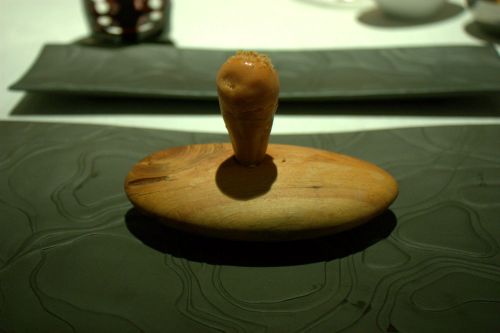
Anchoas: servido en un cornete de pan y tomate. The English translation on the menu I received at the end of the meal (and which I’ll be using here verbatim, odd translations included) simply says anchovies in a coronet with bread and tomato, but the cone itself is the bread and tomato. Admittedly, those flavors take a back seat to the cold salty fish ice cream. Perfect in a bite but you probably wouldn’t want a whole bowl of it. There were a lot more ice creams to come.
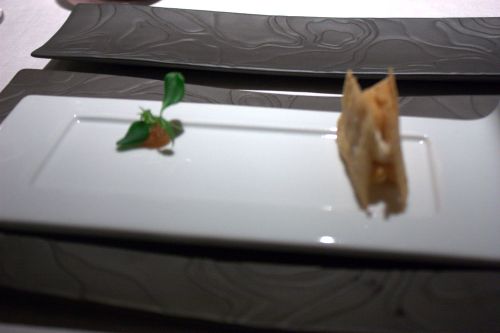
“Bocata”: de calamares fritos con mermelada de limon/Baby Squid: fried in a sandwich with mayonnaise and lemon jam. This was gone in a flash and I hate to say that I barely remember it. Though I never tried one, battered, fried calamari ring sandwiches are common street food in Madrid so I got that this was a tweak on that but didn’t have memory of the original to compare it to.
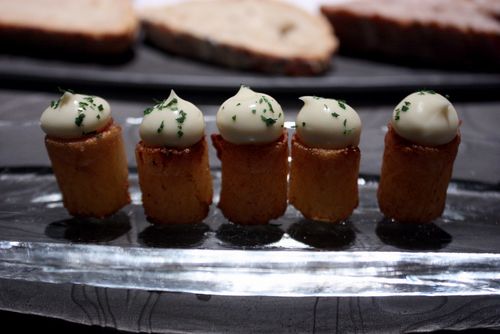
Las Patatas: “bravas” al estilo Arola/Potatoes: “bravas” Arola-style (spicy fried potatoes). Ok, these were freaking adorable and fun to eat. This is when we noticed that the chef loves doing tiny food. Not in an obnoxious way, though. The crispy little potato cylinders were hollow inside and housed the lightly spiced tomato sauce, capped with dollops of aioli. This was a play on a classic dish that I totally understood.
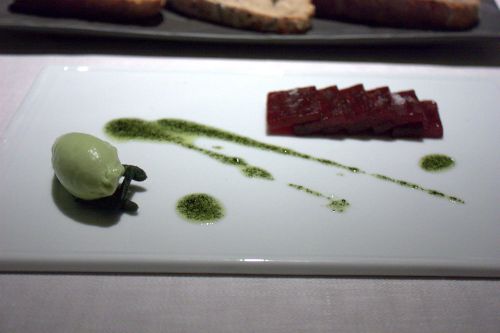
Remolacha: en “sashimi” al estilo de Alain Passard con helado de aguacate/Beetroot: Alain Passard “sashimi” style, avocado ice cream. I see they’re being all British with the beetroot instead of plain ol’ beets. I have never eaten at L’Arpege or in Paris (technically, I probably ate something there in ’89 when my student exchange group spent the night in the capital before flying back to the US) so I can’t speak to the homage. The slightly sweet, toothsome squares of beet paired well with the cold, creamy avocado. I feel like there was a licorice component tying this dish together but I don’t see overt evidence of that on the plate.
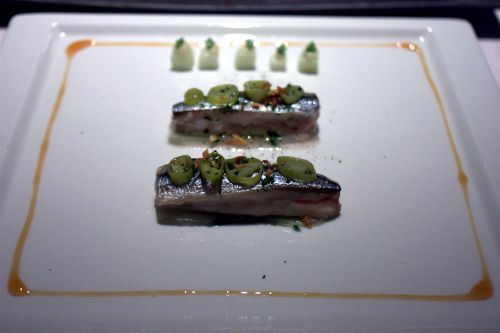
Boquerones: “a la Espalda” con ensalada de manzana y sirope e sidra/Fresh anchovies: “a la Espalda” style with apple salad and cider syrup. We loved this not just for the bright, tangy flavors but for the insane attention to miniature detail. In the background are the world’s tiniest cubes of apple topped with a lentil-sized dab of sauce and finished with a baby leaf of what I think was parsley (whenever I think an herb is exotic and ask, it turns out to be parsley). James pictured a hamster chef crafting Lilliputian food. I imagined a perfectionist Japanese intern slaving away in the kitchen over these precision tasks (I’ve seen more than a few behind the scenes photos of high end Spanish restaurants, and I swear there’s always a young Japanese guy present).
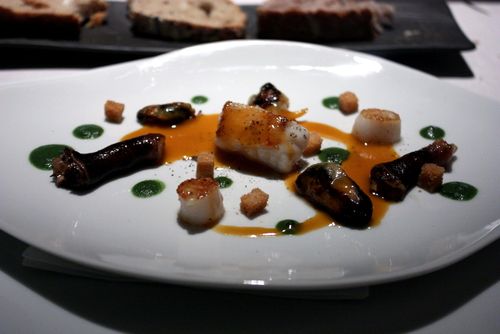
Parrillada: de pescado y marisco con un jugo natural y mojo de algas/Barbecue: fish, seafood with a natural juice and seaweed “mojo.” Lots of delicate grilled things from the sea. I was excited to try percebes, those rare prehistoric looking goose barnacles, and made a point to savor them. Yet now, just a few weeks later I can’t dredge up how they tasted.
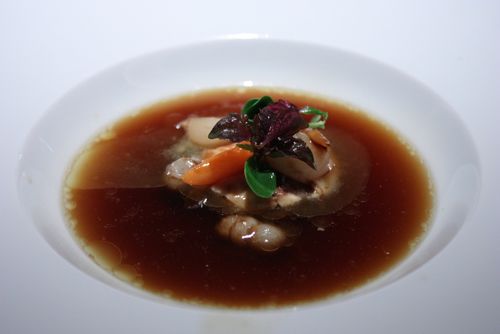
Foie Gras: en “torchon” rellena de confit de pato con verdures y sopa de cabello de angel/Foie Gras: “torchon” stuffed with duck confit with vegetables and its consommé. Sometimes tasting menus go wild with foie gras and kill you with heaviness too soon. This was the first very rich dish, though it wasn’t overwhelming because the consommé added a sense of lightness.
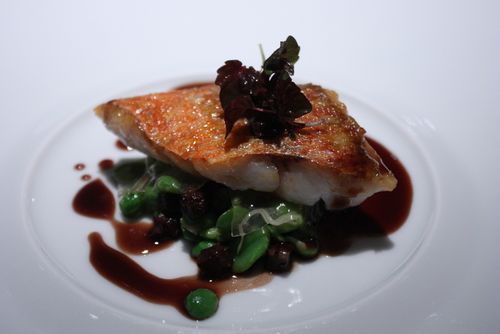
Red Mullet: beans and peas sautéed with black sausage and fat Iberian ham. The above series of dishes come to everyone then you can select your fish and meat courses. This was mine and it was perfect for me. Beans and morcilla always go well together, the firm buttery fish had wonderfully crisped skin and there was a hint of salty, porky jamon. I prefer fish dishes that have a little heft.
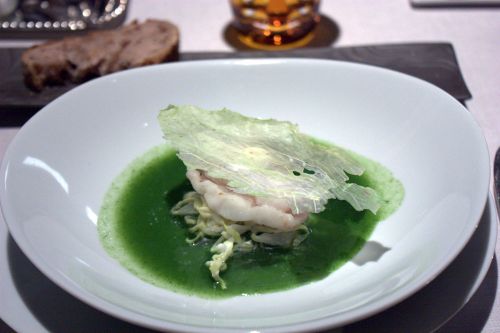
Lenguado: con manteca de setas, col picuda y gnoquis de cítricos. James’ sole was on the lighter side and came with mushrooms, cabbage and a single gnocchi served on a spoon.
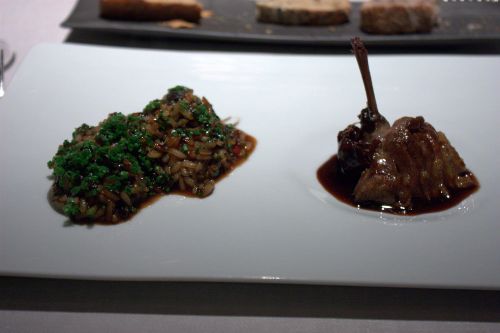
Pigeon: basmati rice stewed with candied fruits and vegetable, charcoal grill oil. I also like dark meat and sweets together so this Moroccan riff was an obvious choice. The rice was little chewy-firm and after serving tableside there was quite a bit left over in the pan. I wondered what they did with the extras and shortly found out: they offer seconds.
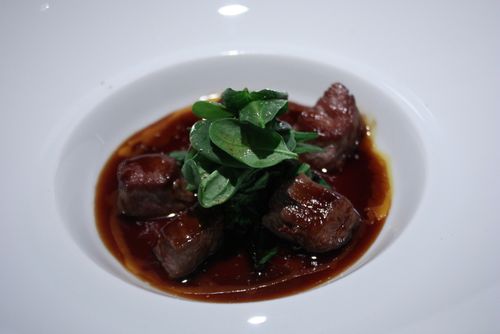
Cerdo Blanco: fricasé, tirabeques y espinacas. James’ meat course. I’m not sure what is meant exactly by white pork, if it’s a specific breed or a pig that is fed a particular diet. This almost looks like Shanghainese food to me. The spinach is on top, I’m not sure where the snap peas are.

Coco: lágrimas de tamarindo y naranja sanguina/Coconut: tamarind tears and blood orange. The first of the desserts and it was certainly pretty and refreshing. This was mostly fruity even with the creamy island of coconut. I think by “tamarind tears” they are referring to the little brown dots on the white puck, interspersed with mint leaves.
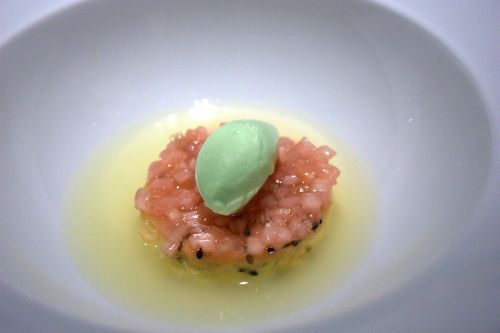
Ruibarbo: guisado en frio con helado de guisantes y sopa de piña/Rhubarb: cold stew with peas ice cream and pineapple soup. This was unmistakably rhubarb, a fruit I had never associated with Spain. The pineapple broth doubled the sweet tartness and the pea ice cream…I’m not really sure. If anything, it tamed the fruits’ sharpness.
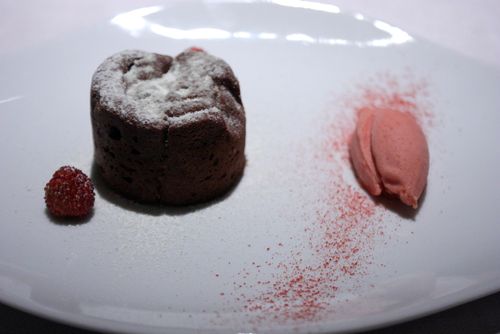
El Chocolate: coolant a la pimiento verde y helado de fresas/The Chocolate: green pepper coolant and strawberry ice cream. I was wary of this one not so much because I’m anti-molten cake but because I’m not wild about bell peppers. It turned out that green pepper meant jalapeno or a similar green chile pepper. There was tingly heat with no overwhelming vegetal bluntness. Nice.
I was happy that at the end of the meal you are presented with a dated menu detailing what you just ate. High caliber restaurants usually provide menus if asked but I prefer it being a given because I am a dork that way. The amusing thing was that apparently it was determined at some point that James was more adept with the language because his menu was in Spanish and mine was in English. I was not insulted, though I didn’t think my Spanish was that abysmal. It is handy for comparing translations such as black sausage for morcilla. I would say blood sausage but maybe that didn’t sound appealing.
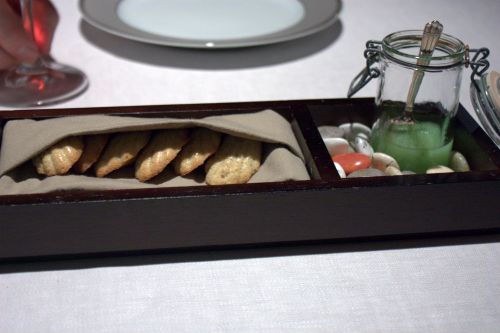
After dinner madelines are served with citrus candy that look like pebbles and a lime jam. Another couple that came in at 11:30pm (we were early birds at 9:30pm), the ones who had beers as an aperitif, blew through their meal before we were done and took their candy tray with them downstairs to the small bar. We followed soon after. The sleek room was occupied by a good number of young rich kids, kind of like a Madrileño cast of Gossip Girl.
I had an exemplary whisky sour, with egg white foam and all; it was finely crafted and should be for 12 euros. Maybe we frequented chichi bars but I found drinks to be Manhattan in price. Fun, deco Museo Chicote, across the street from our hotel had 10 euro gin and tonics (but they were enormous) and Del Diego, just behind Museo Chicote, (which I had to visit because the Time Out guide described it as ‘80s Wall Street and I wanted to see what a British writer’s idea of that era might look like) had similarly priced cocktails. And no, it didn’t remind me of Wall Street in the least. And of course in all venues, you could puff away till your lungs burst, and 90% of the imbibers were doing just that.
Sergi Arola Gastro * Calle de Zurbano 31, Madrid, Spain

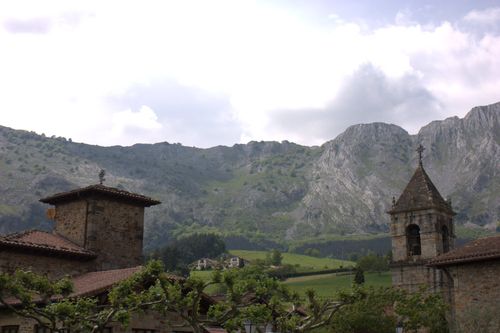
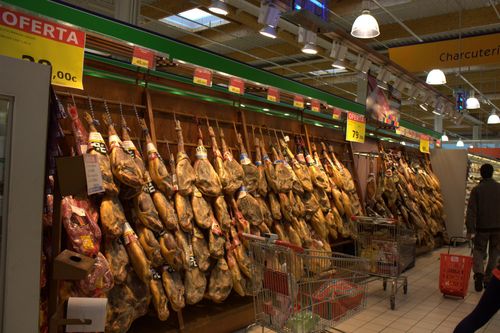
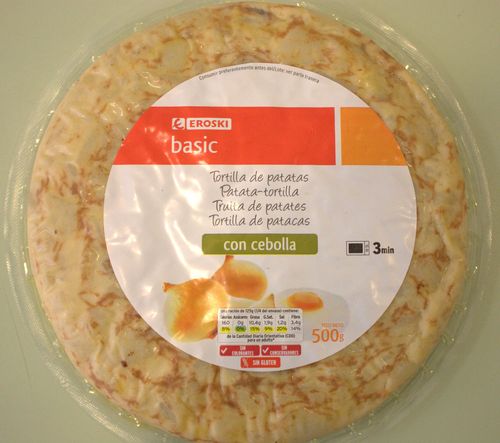
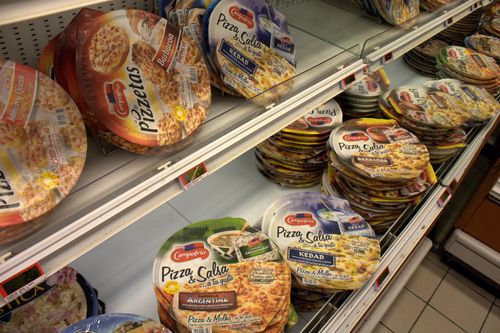
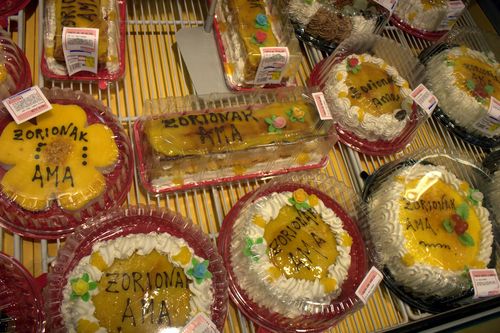
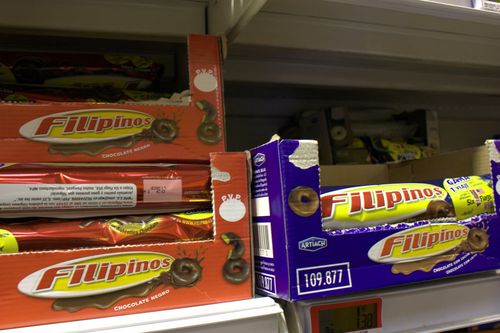
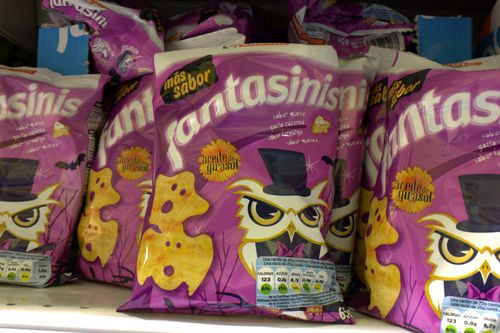





 Follow
Follow

 Goiz-Argi was a good place to start. On a Wednesday night, our first night and still getting our bearings, this compact bar had enough breathing room to survey the small selection of fairly traditional pintxos on the counter and listed on the wall.
Goiz-Argi was a good place to start. On a Wednesday night, our first night and still getting our bearings, this compact bar had enough breathing room to survey the small selection of fairly traditional pintxos on the counter and listed on the wall.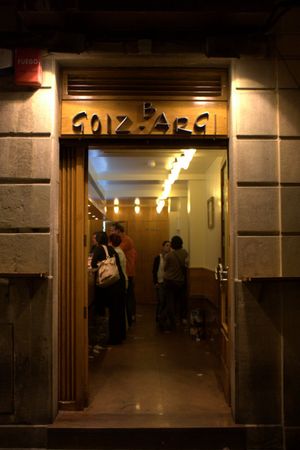
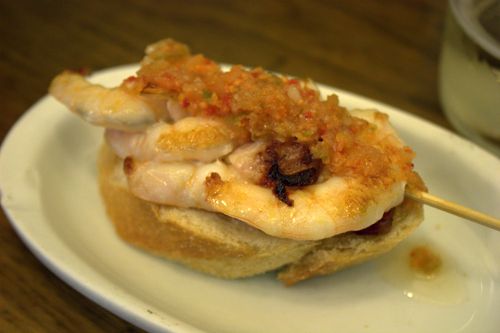
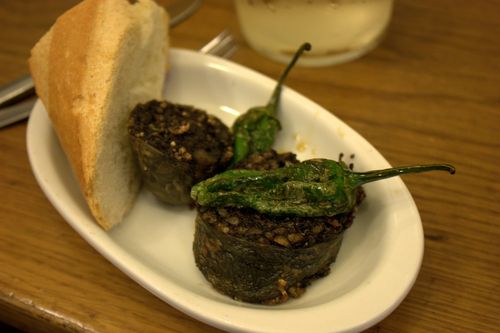
 Zeruko, where foie gras hides in every crevice and otherwise responsible adults leave sleeping infants unattended in strollers out front, turned out to be one of my favorite places to eat in San Sebastián. (In the late ‘90s
Zeruko, where foie gras hides in every crevice and otherwise responsible adults leave sleeping infants unattended in strollers out front, turned out to be one of my favorite places to eat in San Sebastián. (In the late ‘90s 
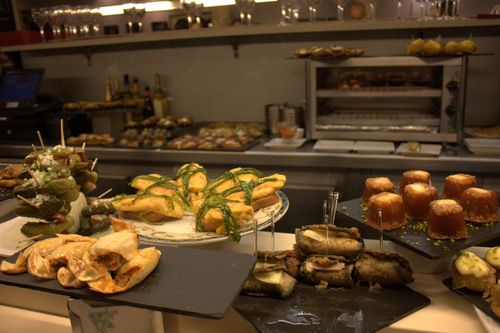
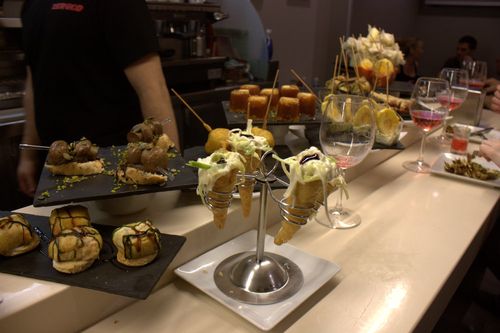

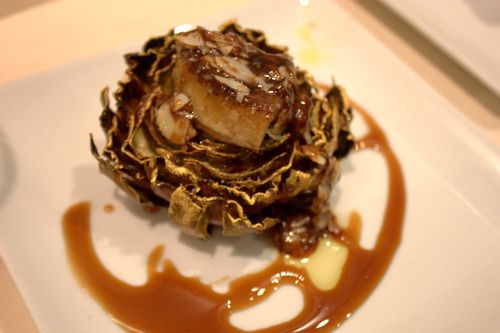
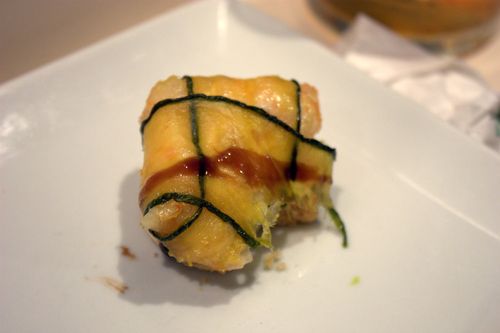
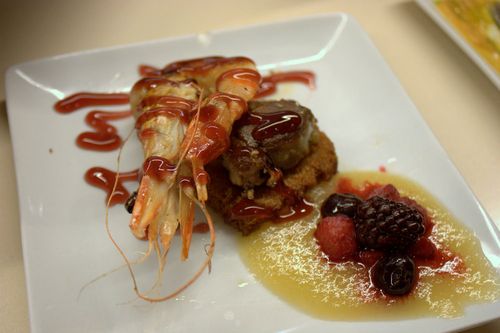
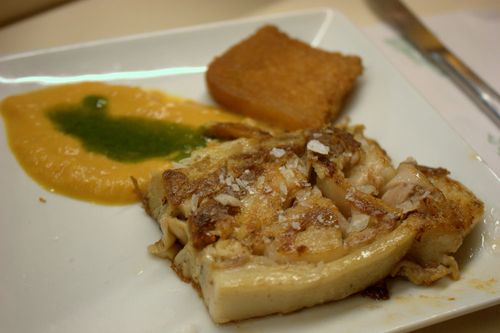
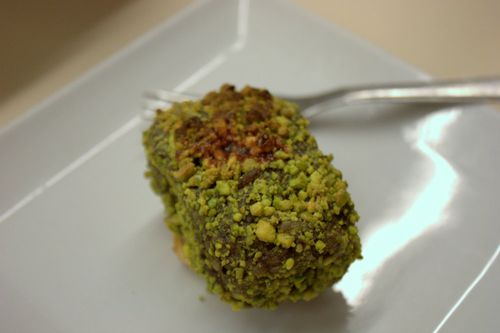
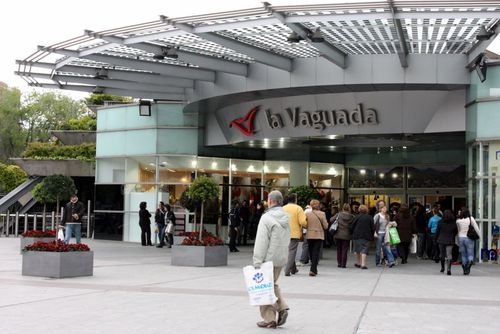


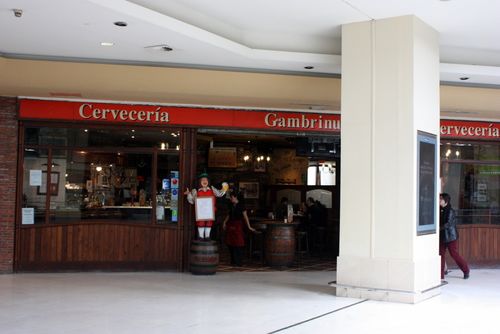
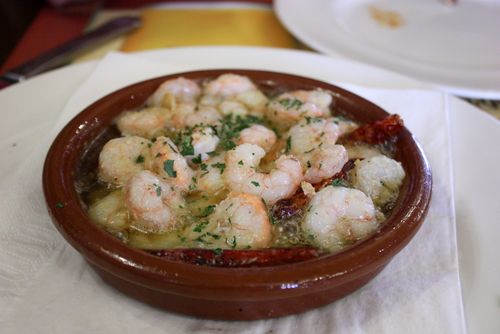
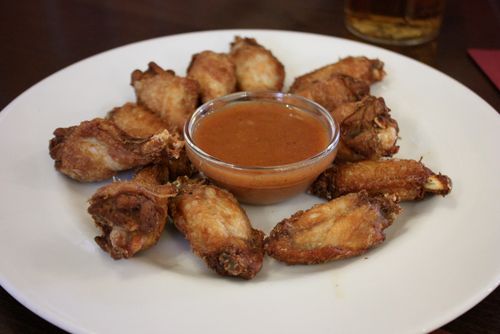

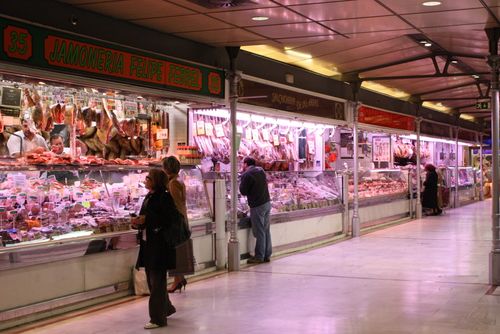
 Kulto al Plato appears to have next to nothing written about it in English. I only knew that it had won best tapas bar of 2008 from Metrópoli magazine, which could mean anything. No one ever agrees with best ofs and I'm not sure what kind of weight that publication holds among food-lovers in Madrid.
Kulto al Plato appears to have next to nothing written about it in English. I only knew that it had won best tapas bar of 2008 from Metrópoli magazine, which could mean anything. No one ever agrees with best ofs and I'm not sure what kind of weight that publication holds among food-lovers in Madrid.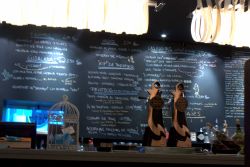
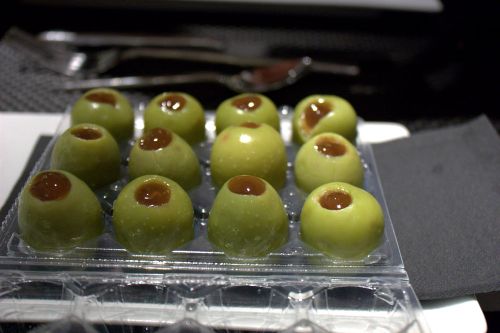

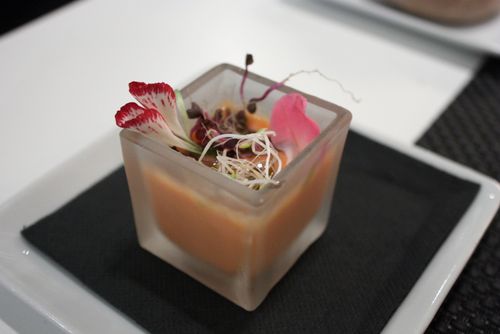
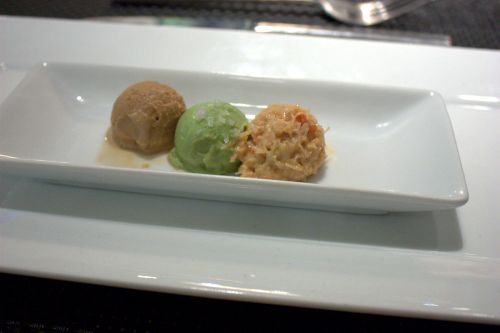
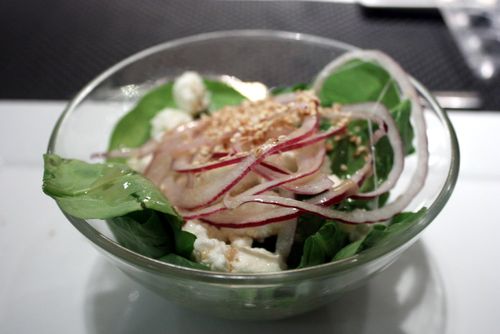
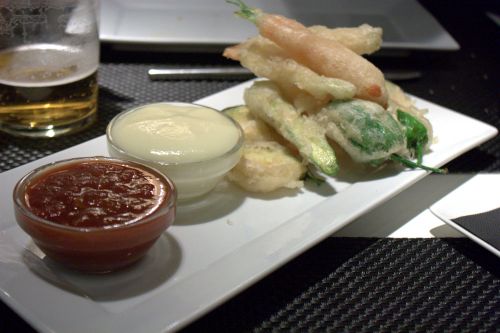
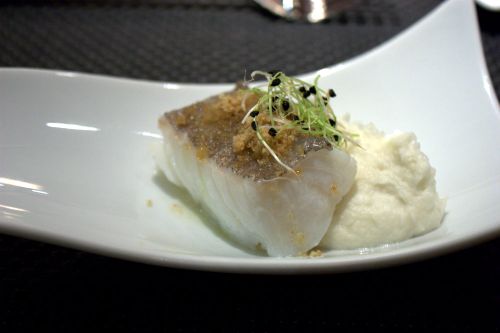
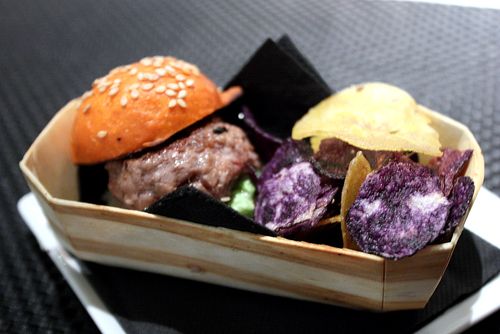





















 1/2 I wouldn't recommend Café Nebraska to anyone unless they were nostalgic for the European trip taken with their mom and sister when they were 15. No, I’m not talking about myself. My family's vacations rarely consisted of more than a two-hour drive to the Oregon Coast. (To be fair, there was a 1984 Disneyland excursion where I watched part of Stop Making Sense in the motel room adjacent to my parents, not knowing what to make of David Byrne's oversized jacket, and a trip to Vancouver B.C. where my dad was too bashful and Hank Hill to go into any of the over-18 shops to buy the Duran Duran posters hanging in the window that my sister and I were clamoring for.)
1/2 I wouldn't recommend Café Nebraska to anyone unless they were nostalgic for the European trip taken with their mom and sister when they were 15. No, I’m not talking about myself. My family's vacations rarely consisted of more than a two-hour drive to the Oregon Coast. (To be fair, there was a 1984 Disneyland excursion where I watched part of Stop Making Sense in the motel room adjacent to my parents, not knowing what to make of David Byrne's oversized jacket, and a trip to Vancouver B.C. where my dad was too bashful and Hank Hill to go into any of the over-18 shops to buy the Duran Duran posters hanging in the window that my sister and I were clamoring for.)













